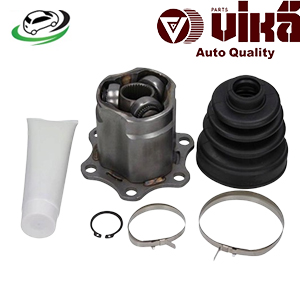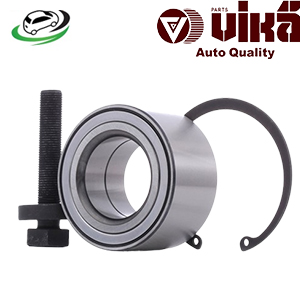-4%
Get VW Amarok 10 VW Amarok 10 Front Wheel Bearing Kit 2H0498627
A front wheel bearing kit typically includes all the necessary components to facilitate the proper functioning of the wheel bearings in the front axle of a vehicle. Wheel bearings are essential for allowing the wheels to rotate freely with minimal friction while supporting the vehicle’s weight.
1.1. Components of the Front Wheel Bearing Kit
A typical front wheel bearing kit consists of:
- Wheel Bearings: These are the primary components that allow for the smooth rotation of the wheel.
- Outer and Inner Races: The races are the inner and outer rings that house the bearing balls or rollers.
- Bearing Balls or Rollers: These are the elements that reduce friction and facilitate smooth movement between the races.
- Seals or Dust Caps: These protect the bearings from dirt, debris, and moisture, ensuring longevity and performance.
- Grease: High-quality grease is included to lubricate the bearings, minimizing wear and heat generation.
2. Functionality of Wheel Bearings
2.1. Load Support
The primary function of wheel bearings is to support the weight of the vehicle, allowing it to maintain stability and control while driving. This is particularly important for the front wheels, which bear the weight of the engine and front axle components.
2.2. Smooth Rotation
Wheel bearings facilitate the smooth and efficient rotation of the wheels. They reduce friction between the rotating parts, allowing the vehicle to move freely with minimal resistance.
2.3. Alignment and Stability
Properly functioning wheel bearings help maintain the alignment of the wheels, contributing to overall vehicle stability. This is crucial for effective steering and handling, particularly during cornering and braking.
3. Types of Front Wheel Bearings
There are several types of front wheel bearings, each designed for specific applications and performance requirements:
3.1. Ball Bearings
- Design: These bearings consist of spherical balls positioned between the inner and outer races.
- Applications: Commonly used in light-duty vehicles, they provide good radial load capacity and moderate thrust load capability.
3.2. Roller Bearings
- Design: These bearings use cylindrical rollers instead of balls, offering a larger surface area for load distribution.
- Applications: Often found in heavier vehicles, roller bearings provide greater load capacity and are suitable for high-stress applications.
3.3. Tapered Roller Bearings
- Design: These bearings feature conical rollers and are designed to handle both radial and axial loads. The taper allows for better alignment under load.
- Applications: Common in trucks and SUVs, tapered roller bearings provide excellent stability and strength for front wheel applications.
3.4. Hub Units
- Design: Hub units are integrated assemblies that combine the wheel bearing and wheel hub into a single unit. They often come pre-greased and sealed.
- Applications: Increasingly popular in modern vehicles, hub units simplify installation and maintenance, providing enhanced durability.
4. Benefits of Using a Front Wheel Bearing Kit
The front wheel bearing kit offers numerous advantages for vehicle performance, safety, and longevity:
4.1. Improved Handling and Stability
High-quality wheel bearings contribute to improved vehicle handling and stability. Properly functioning bearings ensure that the wheels maintain their alignment, enhancing steering response and control.
4.2. Reduced Friction and Heat
Effective wheel bearings minimize friction, leading to reduced heat generation during operation. This can enhance the longevity of the bearings and other related components, such as brake pads and tires.
4.3. Enhanced Durability
Quality front wheel bearing kits are designed to withstand significant loads and stresses, contributing to the overall durability of the vehicle’s suspension and wheel assembly.
4.4. Noise Reduction
Well-maintained wheel bearings can significantly reduce noise during operation, providing a quieter and more comfortable driving experience.
4.5. Cost-Effectiveness
Using a complete front wheel bearing kit can be more cost-effective than purchasing individual components separately. It ensures that all necessary parts are replaced simultaneously, reducing the risk of future failures.
5. Common Issues with Front Wheel Bearings
Despite their durability, front wheel bearings can experience issues that affect vehicle performance:
5.1. Wear and Tear
Over time, wheel bearings can wear out due to constant stress and friction. Signs of wear may include noise, vibration, and decreased handling.
5.2. Moisture Contamination
If the seals or dust caps are damaged, moisture and debris can enter the bearing assembly, leading to rust and corrosion. This contamination can significantly reduce bearing life.
5.3. Improper Installation
Incorrect installation of wheel bearings can lead to premature failure. It’s crucial to follow manufacturer specifications and guidelines during installation.
5.4. Grease Degradation
The grease used in wheel bearings can degrade over time due to heat and contamination. Insufficient lubrication can result in increased friction and wear.
5.5. Alignment Issues
Poor wheel alignment can place excessive stress on wheel bearings, leading to uneven wear and potential failure. Regular alignment checks are essential for vehicle maintenance.
6. Signs of Failing Front Wheel Bearings
Recognizing the symptoms of failing front wheel bearings is essential for timely intervention and repair:
6.1. Noise
A common sign of a failing wheel bearing is a grinding or humming noise that increases with vehicle speed. This noise may become more pronounced when turning.
6.2. Vibration
Excessive vibration felt in the steering wheel or throughout the vehicle may indicate worn or damaged bearings.
6.3. Play in the Wheel
If there is noticeable play or looseness in the wheel when grasped and shaken, it could indicate a failing wheel bearing.
6.4. Uneven Tire Wear
Worn wheel bearings can cause misalignment, leading to uneven tire wear. Inspecting tire condition regularly can help identify potential issues early.
6.5. ABS Light Activation
In vehicles equipped with an Anti-lock Braking System (ABS), failing wheel bearings can trigger the ABS warning light due to irregular wheel speed readings.
7. Maintenance of Front Wheel Bearing Kits
Proper maintenance of the front wheel bearing kit is essential for ensuring longevity and performance:
7.1. Regular Inspections
Conduct regular inspections of the wheel bearings and related components. Look for signs of wear, such as noise, vibration, or play in the wheels.
7.2. Check Seals and Dust Caps
Inspect seals and dust caps for damage or wear. Replace them as necessary to prevent moisture and debris from contaminating the bearings.
7.3. Lubrication
Ensure that wheel bearings are properly lubricated. In some cases, bearings can be repacked with grease, but sealed hub units typically do not require this.
7.4. Alignment Checks
Regularly check the alignment of the wheels. Proper alignment reduces stress on the wheel bearings and contributes to even tire wear.
7.5. Professional Maintenance
Consider having wheel bearings and related components inspected by a professional during regular maintenance services. A trained technician can identify potential issues early and recommend necessary repairs.
8. Conclusion
The front wheel bearing kit is a vital component of a vehicle’s wheel assembly, enabling smooth rotation and supporting the vehicle’s weight. Understanding the functionality, types, benefits, and common issues associated with front wheel bearings is essential for vehicle owners. Regular maintenance, including inspections and timely replacements, can prevent significant problems and ensure optimal performance and safety. By prioritizing the health of the front wheel bearing kit, drivers can enjoy a smoother ride, improved vehicle handling, and enhanced longevity of their vehicle’s drivetrain.
Follow us on Facebook for more parts.




Reviews
Clear filtersThere are no reviews yet.